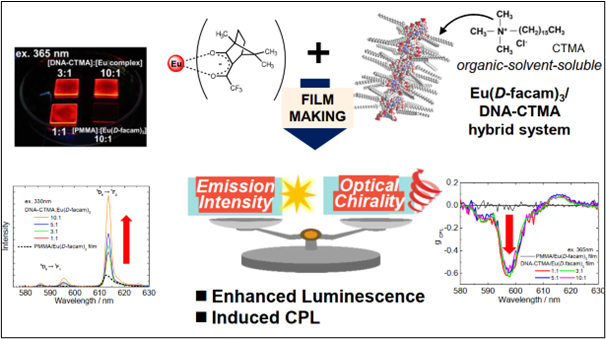Advantages
By incorporating a chiral Eu(III) complex into the membrane of DNA, a chiral biopolymer, high-intensity light emission, and highly circularly polarized light emission are simultaneously achieved.
・ Increased photoluminescence by more than 25 times the luminescence quantum yield due to interaction with DNA
・ Emission circular polarization degree (glum value) is -0.6
Background&Technology
Chiral luminescent materials exhibiting circularly polarized luminescence (CPL) are expected to be used as next-generation optical information functional materials, such as polarized light sources for 3D displays and security systems. In research on circularly polarized light-emitting materials using rare earth complexes, materials with a high degree of circularly polarized light emission have been developed. Still, it has been challenging to achieve both a degree of circularly polarized light and high-intensity light emission.
Because DNA-based materials have unique optical functional properties, they are attracting attention in various fields, such as light-emitting systems, biological systems, and nanodevices. Therefore, we used a film in which a chiral Eu(III) complex (Eu(D-facam)3) was associated with a solid matrix composed of DNA and cetyltrimethylammonium chloride (CTMA). When we investigated the photophysical properties, we observed enhanced photoluminescence (a more than 25-fold increase in luminescence quantum yield) and a degree of circular polarization in the emission (glum = − 0.6) due to the interaction of the Eu complex with DNA.
 |
Figure 1) Enhancement of photoluminescence and degree of circular polarization due to interaction between Eu complex and DNA
Expectations
We hope for joint research and technology licensing aimed at applying circularly polarized light to security inks and special printing.
Published
Nature Scientific Reports 10:18917(2020)
https://www.nature.com/articles/s41598-020-75808-w
Patent
Patent 6218291,WO/2023/277110
Researchers
Professor Norihisa Kobayashi (Chiba University Graduate School of Engineering)
Project No. DD-04779


